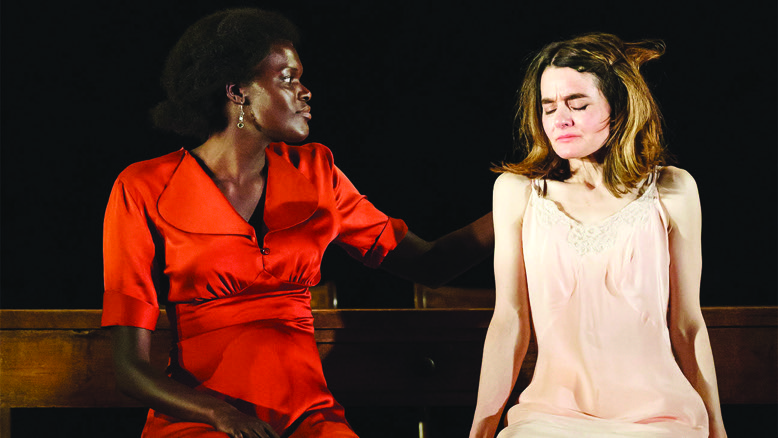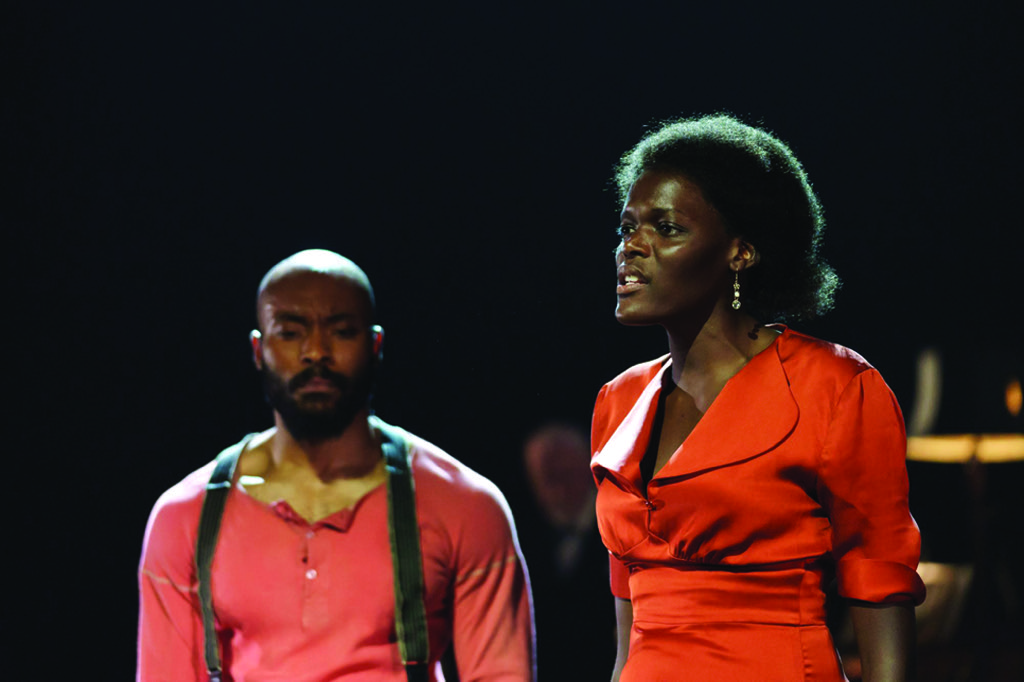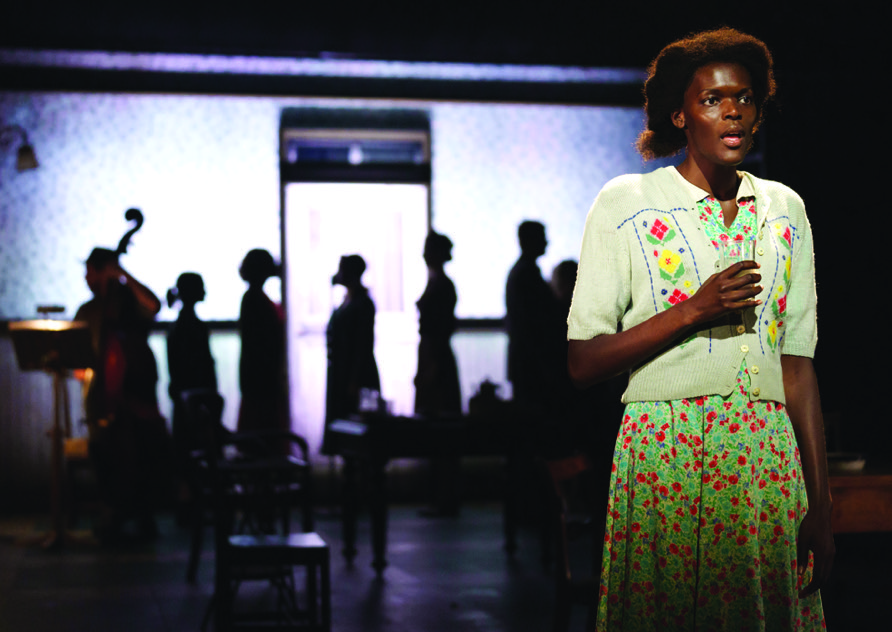Girl from the North Country – Written and directed by Conor McPherson. Music and lyrics by Bob Dylan.
This review, which contains spoilers, ran in Issue 194 of Isis, the Bob Dylan magazine.
Artists who diversify have sometimes been viewed with suspicion. An actor makes music? Bruce Willis crooning Under the Boardwalk springs to mind (don’t bother). A rock star makes a movie? Mick Jagger played a mercenary in Freejack (really, don’t bother). David Bowie’s last work, Lazarus, was a sprawling, experimental piece of theatre which used his songs in a dynamic, thrilling way. But would the play have worked without the music? I don’t think so, and I saw it workshopped in New York and then tightened up in London. In fact, after seeing Girl from the North Country, I wished that Conor McPherson was the Irish playwright that Bowie had engaged, rather than Enda Walsh, the one he did. Because while Lazarus could not stand easily on its feet as a play, Girl from the North Country certainly can. There were a couple of ill-judged parts, more of which later, but on the whole this was a dazzling night at the theatre.

It’s 1934 in Duluth, our man’s birthplace. The Great Depression has taken hold and casts a chill over proceedings like the local cold. The parallels between Dust Bowl America and our own recession, turned into cutting, cruel austerity, are marked. The narrator (Ron Cook), a doctor, introduces us to the scene, and provides grounding throughout. We are in a guesthouse, leaking money and about to be put into foreclosure, run by Nick (Ciarán Hinds), a gruff man with a complex life: a wife with dementia (Shirley Henderson); an adopted African American daughter (Sheila Atim) who is seemingly pregnant at 19 by someone long gone and also being pursued by a predatory, creepy old man (Jim Norton); and a layabout son (Sam Reid) with his head in a whisky bottle most of the time. He has a mistress (Kirsty Malpass, stepping in from the ensemble, superbly), who asks for little, and can’t stick around much longer in this desperate economic climate. We meet a variety of dishonest lodgers, tempers fraying, trying to eke out a living in impossible times.
The dialogue races by, each strand woven together masterfully. I was gripped by the intensity of the storytelling. And then, there’s the music. I thought, how on earth could this work? Will dropping a bunch of Dylan songs into an autonomous play distract? Will Americana arrangements suit? Will the choices make sense given that they can’t further the story? After all, he didn’t write these for the play. And then the first song, Sign on the Window, drifts in and wow, just wow, it all coalesces better than I could have dreamed. A hipster-looking (1930s beards/attire is twenty-first century hipster chic) house band (double bass, piano, fiddle) accompanies the actors, who take turns on percussive instruments. Twenty songs are used to soundtrack lives of anger and passion, sadness and regret, worry and loss. I was sometimes taken out of the moment, if briefly, to reflect: this song is part of me, part of the fabric of who I am. But then a second later I was locked back in to 1934 Minnesota. It’s a tightrope walk and McPherson, previously known for his supernatural works, has aced it. There are no easy choices here: you try and pick 20 Dylan songs out of them all to accompany a plot organically and soundtrack this highly strung chaos.

The performances are remarkable, particularly Henderson as Elizabeth, Nick’s wife. She gives an untethered lightness to the role that is sure to win her buckets of awards; I predict the Olivier for Best Actress. Physically slight, and 51 but looking two decades younger, she is a mismatch for a big man of 64 like Hinds. They don’t convince as a couple in that sense but there is genuine chemistry between them as he tries to cope with her disinhibited behaviour towards the guests. There are no weak links in the company, with Sheila Atim in particular owning the stage during both dramatic and musical moments as a woman who everyone wants to control. Her version of Tight Connection To My Hearttook my breath away; nearly unrecognisable, it is all the better for it. As the stories interlink, and there is much to weave in, we come to a couple of troublesome moments.
A young African American man arrives (played flawlessly by ensemble player Karl Queensborough) and reveals himself to be a boxer just out of prison, so he says. This is a pretty clumsy way to shoehorn Hurricane in later on; it didn’t fit, at all. In fact, after a tight first half, it came off the rails, briefly, shortly into the second. It almost felt like McPherson had lost his own threads and, while he tried to find them, shovelled in a couple of songs that didn’t fit. He pulled it all back together but then took the only major misstep in the play, a storyline of parents and their adult disabled son.

Portraying disability is not easy, and unless it’s central (like in The Curious Incident of the Dog in the Night-time) it’ll come across as throwaway or played for effect. The actors in this plotline were fine enough, with the mother in particular (Bronagh Gallagher) compelling. But a confusing blackmail scenario with a menacing Bible salesman (Michael Shaeffer) led to exposure of their ‘secret’: the son had sexually assaulted a woman and the family had to flee. Their section ends with the father, at the end of his tether, letting his son drown. Then, appearing as a ghost in white clothing, the son (Jack Shalloo) returns to render a gospel-tinged rendition of Duquesne Whistle. None of it worked and such a portrayal of disability was inappropriate and veered to the offensive given that the ghost was miraculously cured of his learning difficulties. This inherent condescension was compounded by a regressive decision to cast this character as dangerous in the first place. I tried my best to forget it, because it should not sully the rest of the play.
I’d decided not to spoil any musical surprises by finding out the ‘setlist’. My dad bought a programme and scanned carefully to see which were to be featured. I turned away, much as I had done for Lazarus: I wanted to gasp with surprise when Jokerman appeared (it was the first Bob song I loved; Infidels came out on my seventh birthday). Or grin and feel an inner thrill at the storming, foot-tapping, tambourine-bashing version of Slow Train, making it sound better than it ever has. I’m not going to drone on about voices, and how these singers give new life to the material. But they do. I don’t need to tell you anything about Bob’s voice, its tenderness in these later years mixing with a road-worn timbre (she said politely). Watching excellent actors embody these songs sets light to them, shooting jolts of electricity through their hearts. And quite frankly, it is no bad thing to have an audience become agog at these lyrics because they can actually hear the deathless words perfectly. It all reinforced my great love for this material; you won’t believe how delightful it is to hear Like a Rolling Stone with a snippet of Make You Feel My Love in the middle. A pleasure to hear tracks from each decade too; it would have been easy to make it all 1960s stuff, given its relative proximity to the 1930s – acoustic renditions would have fitted seamlessly. Instead, there are just three songs from that decade, a welcome, gutsy, non-obvious choice.

McPherson has set himself a challenge and pulled it off. He manages to evoke Thornton Wilder’s classic Our Town as well as the work of Eugene O’Neill. He also makes you want to drag Street-Legal and Infidels out of storage. The songs run between 1963-2012, and each one is judiciously chosen. What Simon Hale, the orchestrator/arranger, has done with them will melt you in your seat; simple but ravishing, these often moving interpretations of music you know inside out will make you hear them anew.
Girl from the North Country, described by McPherson as a ‘conversation between the songs and the story’, is full of life. It is about trying to find hope through suffering and making the best of it. Dylan’s ‘team’ approached McPherson to write and direct this play, no doubt having heard tell of his acclaimed works The Weir (which ran at the home of new theatre, the Royal Court) and Shining City. And of course we know that hands-off Bob is never quite hands-off; even though he played no part in the writing or arrangements of the dialogue or songs, he did send Jeff Rosen to attend rehearsals. The last time the canon was offered it was a flop, a Broadway show in 2006 that closed after three weeks. But this time, gold has been struck. I hope Bob gets to see it and I feel sure he’ll be very proud of this inspired play bearing his name.
Donny McCaslin :: Rich Mix, London :: 15th November, 2016
Originally published on davidbowie.com in March 2017
Make no mistake, Donny McCaslin, this genial giant sax player from California, has had a distinguished career in jazz. He’s spent nearly three decades carving out a groove in modern jazz playing, starting with filling the huge shoes of Michael Brecker in the legendary fusion group Steps Ahead. With three Grammy nominations to his name, he’s become the trusted right-hand man of bandleader Maria Schneider, herself a multiple Grammy winner. The dreaded term ‘crossover’ has come to be applied in jazz to artists who break out of the somewhat closed jazz world (closed to mainstream rock/pop fans, in that sense) and make a break across the aisle. In the 70s it was Herbie Hancock who did it, and even before then Miles Davis – the greatest jazz artist of all time – had broken the mould, with Kind Of Blue becoming the best-selling, and most famous, jazz album of all time.
Historically, plenty of pop musicians (looking at you, Sting) have sought out jazz players on their records to give them a bit of cool. And as a lifelong jazz fan, Bowie was no different, taking on saxophonist David Sanborn and trumpeter Lester Bowie to play on his records, among others. Even Mike Garson, of course, is a jazz player. As we all know, Bowie was one of the great casting directors of our time. But beyond bit parts – musicians popping up – he had never given over an entire record to jazz musicians, until Blackstar. Everyone knows the story now. He wanted to continue his collaboration with Schneider after their magnificent foray with Sue (Or In A Season Of Crime) in 2014. But she had already committed to her Grammy-winning Thompson Fields project. So she pressed a copy of McCaslin’s Casting For Gravity into his hand (having sent him this link to a live version of the track Stadium Jazz first) and suggested they visit Greenwich Village’s Bar 55 to see his quartet (with Mark Guiliana, Tim Lefebvre and Jason Lindner). McCaslin says he spotted Bowie sitting at a table with Schneider, tried to keep calm, as you would, and just concentrate on playing. Shortly after, he got an invite to perform on what would turn out to be Bowie’s last album. Since then, one imagines, his feet haven’t touched the ground as, suddenly, this brilliant, powerful quartet have become among the most famous jazz musicians in the world.
During a short European tour, McCaslin’s group (minus Lefebvre, whose regular gig – with the arena-filling Tedeschi Trucks Band – called; replaced by Jonathan Maron) called at Shoreditch’s Rich Mix, packing out the overheated main room and shaking the walls. They’d dropped into London to play some stuff from his new Beyond Now album, a follow-up to 2015’s excellent Fast Future. You could tell the crowd had some Bowie fans at their first jazz gig present; they looked a bit shell-shocked. As I heard someone say, listening to jazz on record is hardly like seeing it live. It’s so much more visceral, muscular, and frankly, louder than you can imagine, especially with a fusion quartet like the one McCaslin leads. The bass thundered. Lindner’s synthesiser textures lent a cosmic vibe reminiscent of the early 70s electric playing of Keith Jarrett when he was with Miles. Guiliana’s complex, intricate drumming evoked the greats; one can feel comfortable comparing him to all-time greats like Elvin Jones and Jack DeJohnette, alongside recent masters like Brian Blade and Kendrick Lamar’s drummer Ron Bruner Jr. That’s how good he is. Get his 2015 album Family First; you won’t regret it.
McCaslin leads this band through twisting and turning renditions of songs new and old. You might have expected Warszawa to be on the setlist; the band closed with it. Less expected but incredibly welcome were two more Bowie songs. First, one that caused the room to experience a sharp intake of breath – Lazarus. It sent a chill, until of course the sax came in where the voice should have been and then it took off, with the closing section containing some absolutely remarkable playing from McCaslin, who was on fire all evening. Then, a lovely surprise, the very familiar drum part of Look Back In Anger kicked in and off we went. The room was electrified. If you’d never seen a jazz gig before, or even if you’d seen 100, this was a top class night.